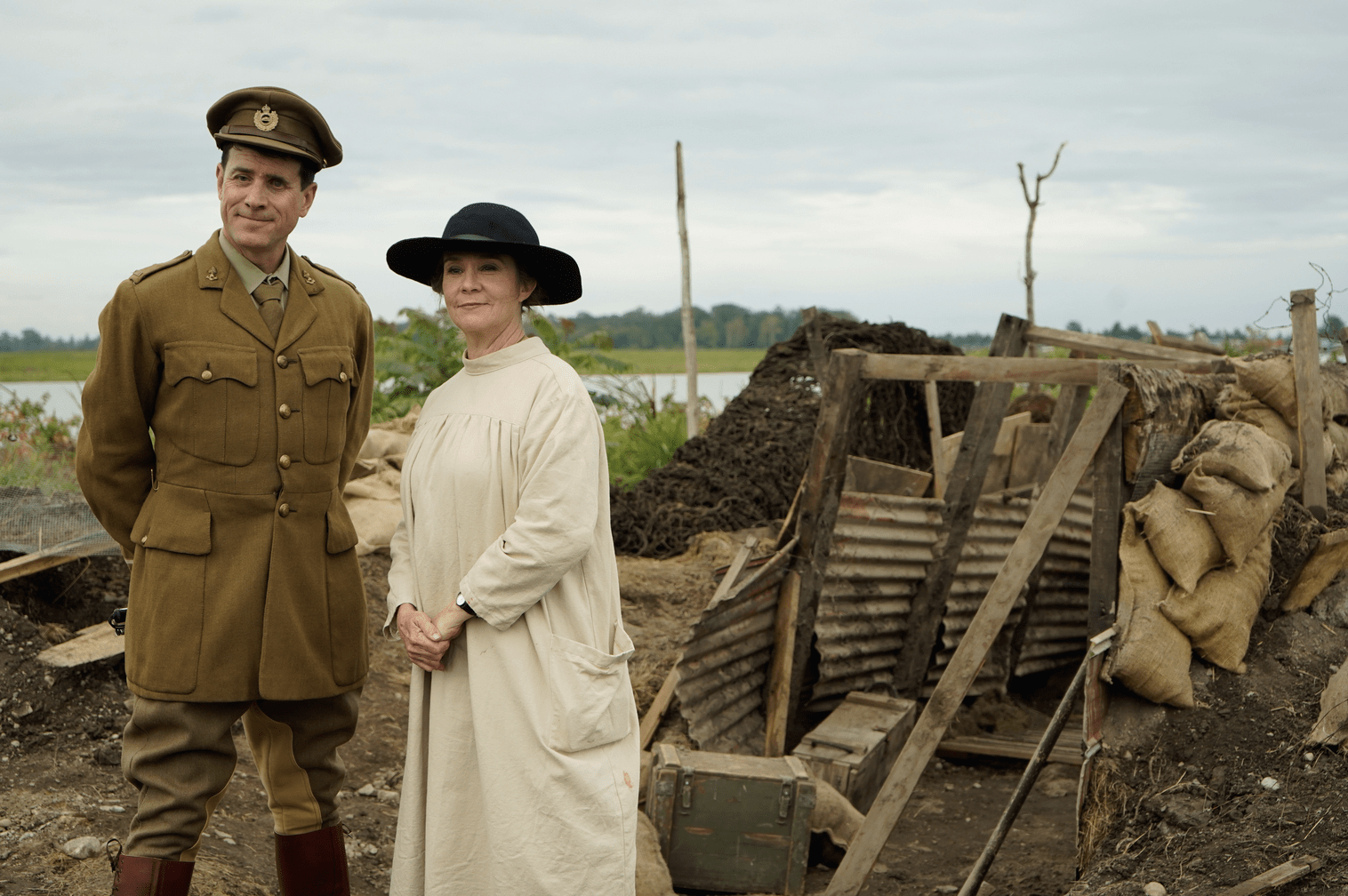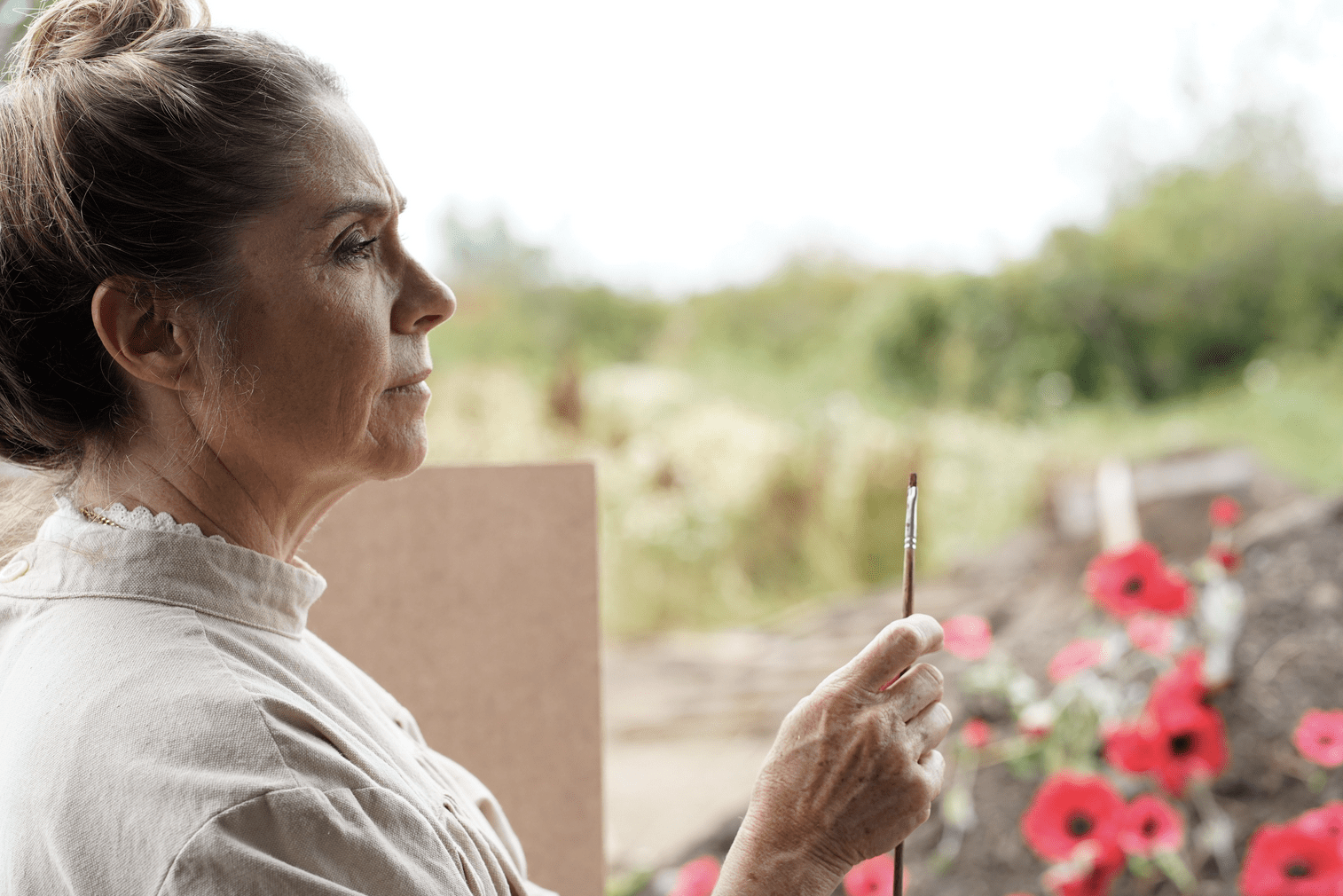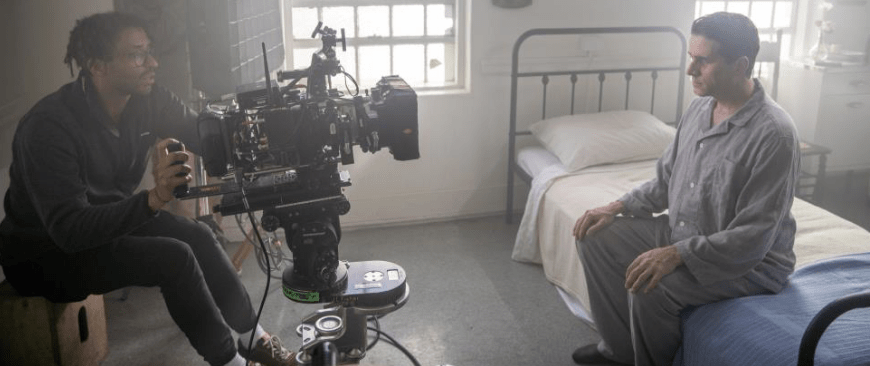The Making of Two Minutes: Dramatizing the Lives of Two Visionary Canadians
 Actors Bruce Horak as Edwin Baker and Megan Follows as Mary Riter Hamilton, on location for Heritage Minutes/Historica Canada
Actors Bruce Horak as Edwin Baker and Megan Follows as Mary Riter Hamilton, on location for Heritage Minutes/Historica Canada
By Anthony Wilson-Smith
August 25, 2024
For the rest of his days, Edwin Baker would never forget the last thing he saw before never seeing again. It was 1915, the First World War, and Baker, a lieutenant in the Royal Canadian Engineers, was serving in Flanders, Belgium. One night, while Baker was on duty in a trench in Mount Kemmel, an enemy sniper failed in his ultimate mission but still changed Edwin Baker’s life — and the lives of countless Canadians — forever. As Baker recounted in an interview decades later, he was standing above the trench-line when “a German star-shell lit up the desolate landscape and, as I watched, a bullet smashed through the bridge of my nose and left me to the mercy of the darkness and my friends.”
During his recuperation at St. Dunstan’s Hostel for Blind Soldiers and Sailors in London, Baker embraced the philosophy of self-reliance and empowerment espoused by its founder, Sir Arthur Pearson. He came home to Canada and, in 1918, co-founded the Canadian National Institute for the Blind (CNIB).
Both vision and war also played epic parts in the life of Mary Riter Hamilton, a Canadian artist whose prodigious pre-war talent gave her entrée to the annual Académie des Beaux Arts Salon in Paris. After failing to secure a place as an official war artist for Canada before the Armistice in 1918, Hamilton, known as Canada’s first female war artist, secured a post-war commission from the British Columbia War Amputations Club, arriving at Vimy Ridge in 1919. She lived and painted until 1922 amid the abandoned trenches, mud, blood, disease, and desolation of post-war European battlefields, creating more than 350 paintings that departed from conventional war art by capturing the intimacy, visceral impact, and human cost of combat. It was her way, she said, of being able “even in a small way to commemorate the deeds of my countrymen.” Hamilton lived for more than three decades after her time in Europe, but her physical and mental health were never the same. She died in the Essondale psychiatric hospital in Coquitlam, B.C., in April 1954 at age 87. She had become so impoverished over the years from health challenges that she was obliged to sell off many of her works at bargain prices, and by the 1930s appeared on the welfare rolls of Vancouver, where she lived.
 Megan Follows as Mary Riter Hamilton at work/Historica Canada
Megan Follows as Mary Riter Hamilton at work/Historica Canada
Baker and Hamilton’s experiences were harrowing and life-altering, but also ultimately affected countless Canadians in powerful ways. Baker not only co-founded the CNIB, he became a role model in demonstrating how sightless people could live fulfilling and productive lives. He learned Braille, business administration, fencing, piano and sculling. Hamilton, through the terrible beauty and pain reflected in her battlefield paintings, opened the eyes of Canadians at home to the true, unglamorous nature of war.
That is why Historica Canada, the charitable organization of which I am president, has produced our latest Heritage Minutes in tribute to each of these Canadians. Both Baker and Hamilton fit within our working rule for the Minutes that they be devoted to people or events that in some way helped shape life in the country in which we live today. That they both made their mark on Canada’s history from the First World War battlefields of Europe meant that this time, it made sense for us to shoot two minutes in one location.
Working with Vancouver-based Scopitone Films, we spent three days in late July shooting both Minutes in venues that included an abandoned building on the grounds of the same psychiatric hospital in Coquitlam, B.C. where Hamilton spent her final days, and a farm in the community of Delta. As for the farm, it became, for this period, a First World War battlefield replete with poppy-strewn trenches (each poppy marking the life of a lost soldier), period-appropriate troop carriers, French poilu infantry alongside Canadians, and nighttime explosive fireworks evoking the last sight Baker saw.
One reason for the longevity and popularity of the Minutes – which routinely draw more than a million viewers in the first month of release alone – is scrupulous attention to detail. Working with external period experts, we spend up to three months in pre-production authenticating everything from dialogue and background scenery details to the colour and type of shoes and clothing worn. We like to say that while Hollywood often describes feature films as ‘based on a true story’ – a nebulous phrase that means they may hold nothing more than a few grains of the original events – our Minutes hew as closely as possible to the truth of history. That same attention applies to casting: in recent years, we have formalized a policy requiring that key creatives – including, of course, actors – be drawn from the communities upon which each Minutes focuses.
 Bruce Horak shooting a scene for the Edwin Baker Heritage Minute/Historica Canada
Bruce Horak shooting a scene for the Edwin Baker Heritage Minute/Historica Canada
In the case of our latest Minutes, both roles needed actors who could show the effects of aging and stress without benefit of the high-priced artificial intelligence techniques that major studios use these days to ‘de-age’ people. For Baker, the clear choice was Bruce Horak, the Calgary-born, now-Stratford, Ontario-based actor who was left with only 10 percent of his vision after a childhood brush with cancer. He has gone on to a multi-faceted career that includes painting, directing and the recurring role of Hemmer in Star Trek: Strange New Worlds.
The role of Hamilton required a 50-something year-old actress – the age she was when she went to France in 1919 – with the acting chops needed to convey tangible physical and mental strain through nothing more than facial expressions, slight makeup changes, and body language. The answer here was Megan Follows, who shot to fame as Anne of Green Gables in the popular CBC series in the late 1980s and has since had an acclaimed career as actress and director on both sides of the border.
The two Minutes have now arrived with the blessing and burden of the high expectations that always accompany new additions to the collection. People often ask about, or reflect upon, their enduring appeal. There are now more than 100 Minutes in our collection: 2026 will mark 35 years since the first ones appeared, and old and new ones alike show up in regular rotation on television stations across Canada at all hours. You can find them anytime on, among many platforms, YouTube, our Historica Canada social channels (with a combined audience of more than half a million subscribers), and, most recently, Rogers Sportsnet during the National Hockey League playoffs and Blue Jays baseball games.
Over the years, the Minutes have been the subject of several doctoral theses, countless media articles, numerous parodies (some very clever; some less so) and have enthusiastic followers in countries including Great Britain, Australia, and the United States. In each of those countries, hosts have YouTube channels devoted to showing and discussing the Minutes and their meaning. In addition to English and French, the Minutes are offered in other languages where appropriate, such as Inuktitut (the Innu artist Kenojuak Ashevak); Japanese (the Japanese-Canadian Asahi baseball team); Dutch (Canada’s role in the Second World War liberation of the Netherlands) and Ojibwe (residential schools/above).
Then, there are the catchphrases, known especially to that generation of Canadians who came of age when the Minutes were introduced in the 1990s. The most notable two are ‘Dr. Penfield, I can smell burnt toast” (a Minute on the world-renowned brain surgeon Dr. Wilder Penfield’) and “I’ve got to stop the train!” (the 1917 Halifax explosion).
Having overseen production of about a quarter of the collection during my tenure of the last decade, I have several theories about their popularity. For one, they speak to a quiet but deep-seated patriotism in many Canadians – one that transcends political and regional divisions. Their bite-sized format is perfect for shortened attention spans in the digital world. Some come off as campy (never mind which) and some are deeply moving (a 2019 Minute on Major Archie MacNaughton’s role on D-Day, below) has been viewed more than 10 million times). We have made considerable efforts in recent years to include stories about people of many different backgrounds who have inspired us, and whose diversity reflects both the contributions and experience of all Canadians.
The Minutes remind us that while lifestyles, dress, speech and conduct change over time, people remain the same in fundamental ways. They look for love, laughter and a sense of accomplishment in life, reflect fear, tears and uncertainty in hard times, and hope, always, that somewhere ahead lies a better life. The best Minutes reflect those pursuits and outcomes in ways to which viewers instantly relate.
In Hamilton and Baker, viewers see those same goals reflected. A 2020 study by the CNIB found that about half a million Canadians are blind, or partially sighted, and another 1.5 million have suffered at least some sight loss. Baker’s efforts – including his role in co-founding the CNIB – have made an enormous difference to these people and their families. It is only fitting that he be brought to life by Horak, who, in his own life, with its wide range of accomplishments, exemplifies all that is possible. Hamilton, whose work has been the subject of an exhibition at the Canadian War Museum in Ottawa in 2018 and a commemorative Canada Post stamp, brought searing images of desolation home in an era before television or widespread use of film. She blazed a trail for women artists – and women overall – through her courage, perseverance and ability.
‘Filmmaking’, the late American director Robert Altman said, “is a chance to live many lifetimes.” A standard feature film, at about two hours length, barely touches the surface of a life – and that is even more true of our productions of 60 seconds. But we hope viewers see them as a door to our past that leads to new awareness and appreciation of a country so infinitely more interesting and accomplished than it is sometimes made out to be.
In Hamilton and Baker, in their achievements, and in dramatizing our collective past through their stories, we find encouragement and inspiration relevant to any era – perhaps none more so than this troubled one.
Anthony Wilson-Smith is president and CEO of Historica Canada.
